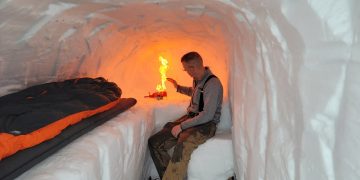For centuries, humans have relied on nature’s subtle signs to forecast the weather. Long before sophisticated meteorological tools and satellite technology, our ancestors carefully observed the sky, animals, plants, and other natural phenomena to predict weather patterns. While modern science has advanced our understanding of meteorology, the age-old practice of reading nature remains both fascinating and surprisingly accurate in many instances.
In this article, we will explore some of the most common natural indicators that can help us predict the weather. From the behavior of animals to the movement of clouds, we’ll uncover how these natural signs work and how you can use them to forecast the weather in your own backyard.
1. Cloud Patterns and Their Significance
Clouds are one of the most visible and obvious weather indicators, and there’s much more to them than meets the eye. Their shape, color, and movement can provide clues about imminent weather conditions.
Cumulus Clouds:
These are the puffy, cotton-like clouds often seen on fair days. However, if they begin to grow taller and develop an anvil-like shape, they may signal the approach of a thunderstorm. The larger and taller the cumulus clouds become, the more likely it is that they will result in rain or even a severe storm.
Cirrus Clouds:
Cirrus clouds are wispy, high-altitude clouds that often indicate that a weather change is on the way. If you see cirrus clouds during a clear day, it may suggest that a weather front is approaching. They are typically a precursor to rain or a storm within the next 24 hours.
Stratus Clouds:
These low, gray clouds often bring overcast skies and light precipitation such as drizzle or rain. If stratus clouds appear in the sky, it’s often a sign of steady, light rain or overcast conditions throughout the day.

Mackerel Sky:
A sky dotted with small, white, and fluffy clouds arranged in rows often indicates the approach of a warm front and rain within the next 12 to 24 hours. This phenomenon, known as a “mackerel sky,” is a classic predictor of changing weather patterns.
2. Animal Behavior as Weather Predictors
Animals have an innate ability to sense subtle changes in atmospheric pressure, temperature, and other environmental factors. This sensitivity has led to various behaviors that can help humans predict the weather.
Birds:
Birds are highly sensitive to atmospheric pressure changes. For example, if you notice birds flying low to the ground, it could signal that a storm is approaching. This behavior is often seen as a reaction to lower air pressure, which is associated with bad weather. Conversely, if birds are flying higher than usual, it might indicate that the weather is improving.
Frogs and Crickets:
The croaking of frogs and the chirping of crickets can also serve as weather indicators. Frogs tend to croak more frequently before rain, especially when the humidity increases. Similarly, crickets are known to chirp more in warm, humid weather. If their chirping increases, it might be a sign that rain is on the way.
Cows and Sheep:
Farm animals like cows and sheep are also sensitive to weather changes. Cows often lie down when rain is imminent, possibly due to the pressure changes in the atmosphere. Sheep may huddle together or move into shelter when they sense an incoming storm.
3. Wind Direction and Speed
Wind plays a critical role in weather prediction. The direction and strength of the wind can indicate whether a storm is approaching or if fair weather will persist.
Wind from the East:
An old saying goes, “When the wind is from the east, the weather is in the least.” This suggests that winds coming from the east are often associated with cold and damp weather, particularly in coastal regions. An easterly wind may signal the arrival of a low-pressure system, leading to rain or cooler temperatures.
Wind from the South:
In many parts of the world, a southerly wind is often a sign of warm, dry weather. For example, in the United Kingdom, winds from the south bring warmer temperatures and higher pressure, often resulting in sunny conditions.
Wind from the North:
Conversely, winds from the north are typically linked to colder and drier weather. In many regions, a northern wind brings a drop in temperature and often signals the onset of winter-like conditions.
Strong Winds:
A sudden increase in wind speed can also be an indicator of an approaching storm or low-pressure system. The stronger the winds, the more likely it is that rain, snow, or even a thunderstorm will occur.
/https://tf-cmsv2-smithsonianmag-media.s3.amazonaws.com/filer_public/a8/00/a800e62f-df04-4d37-8baa-11a924e35adb/gettyimages-915284368.jpg)
4. Pressure Changes
The pressure in the atmosphere can tell you a lot about upcoming weather. A sudden drop in atmospheric pressure is typically associated with stormy conditions, while high pressure often brings clear skies and settled weather.
Rising Pressure:
If the pressure is rising, this generally signals fair, clear weather. High-pressure systems are typically associated with sunny days, calm winds, and dry conditions.
Falling Pressure:
A drop in atmospheric pressure, on the other hand, is usually a sign that a storm is coming. As pressure drops, the atmosphere becomes more unstable, which can result in rain, thunderstorms, or even snow.
One easy way to monitor pressure changes is by using a barometer, a device that measures atmospheric pressure. Many weather stations and home meteorology kits come equipped with a barometer for this purpose.
5. The Color of the Sky and the Sun’s Behavior
The color of the sky and the sun’s behavior can offer important clues about upcoming weather.
Red Sky in the Morning:
The old adage “Red sky in the morning, sailors take warning” is rooted in truth. A red sky in the morning often signifies that a low-pressure system, such as a storm, is on its way. The red color is caused by the scattering of sunlight through dust particles, which are often associated with an approaching weather front.
Red Sky at Night:
“Red sky at night, sailor’s delight” suggests that a red sky at sunset is a sign of good weather ahead. This is because, in many cases, a red sky in the evening is caused by high-pressure systems, which often bring calm and pleasant weather.
Halo Around the Sun or Moon:
A halo around the sun or moon, caused by the refraction of light through ice crystals in the atmosphere, is often a sign that rain or snow is on the way. This is because halos are typically caused by the presence of cirrostratus clouds, which precede a weather front.
6. The Behavior of Trees and Plants
Trees and plants can also offer valuable clues to changing weather patterns. Their responses to temperature and humidity changes can be very accurate.
Tree Leaves:
Before a storm, tree leaves may begin to flutter or tremble, even if the wind is relatively calm. This is because changes in atmospheric pressure affect the way leaves respond to the environment. Additionally, some trees, like birches, will “close” their leaves just before rain, as they respond to the humidity and air pressure changes.
Flowers and Plants:
Certain flowers and plants are sensitive to changes in temperature and humidity. For instance, the petals of flowers like the morning glory will often close before a rainstorm, and some types of flowers will open in the evening to anticipate a change in weather.
Conclusion
Although modern meteorology provides us with a more accurate and reliable way of forecasting the weather, the age-old practice of observing nature is still a valuable skill. The behavior of animals, changes in cloud formations, and shifts in the wind can all offer us important insights into upcoming weather patterns. While no natural indicator is foolproof, understanding the subtle signs around you can give you a pretty good idea of what the skies hold in store.
By paying attention to nature’s clues—whether it’s the way birds fly, the color of the sky, or the movement of the clouds—you can become your own weather forecaster, just like our ancestors did long ago.























